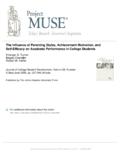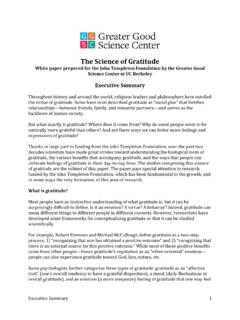Transcription of Construction and Validation of Scale of Parenting Style
1 ISSN: 2320-9038 Volume 2, Issue 4 (2014) _____ Page 315 Guru Journal of Behavioral and Social Sciences Construction and Validation of Scale of Parenting Style Abdul Gafoor, K* & Abidha Kurukkan** *Associate Professor, Department of Education, University of Calicut, Kerala, India. **Research Scholar, Department of Education, University of Calicut, Kerala, India. Received: 16 Oct 2014 Revised: 18 Nov 2014 Accepted: 12 Dec 2014 Keywords: Parental responsiveness, Parental control, Authoritarian Parenting , Negligent Parenting , Authoritative Parenting and Permissive Parenting Abstract This paper describes the development and standardization of a measure of perceived Parenting Style .
2 The four styles namely authoritative, authoritarian, permissive and negligent proposed by Baumrind (1971) are scaled based on a quadrant of high and low levels of parental responsiveness and control suggested by Maccoby and Martin (1983). The items are constructed on socio-cultural and educational circumstances of adolescent students in Kerala, India. Hence, the tool will be largely suitable for scaling the four Parenting styles among south Asian adolescent students. The tool has good criterion related validity and test-retest reliability. 2014 Guru Journal of Behavioral and Social Sciences Parents have huge impact on a person s life. Number of studies in the area of Parenting matches its importance on the developing person. Parenting process combines all the activities of the parents that intended to support their children s wellbeing.
3 One of the most studied approaches to understanding parental influences on human development is concept of Parenting Style (Baumrind, 1967). Baumrind proposed Parenting styles as correlates to socialization of the children. Then many researches recognized the importance of researching role of Parenting Style in child development (Kordi, 2010; Schaffer, Clark & Jeglic, 2009; Kaufmann, et al, 2000; Lim & Lim, 2003). Many of the studies followed three Parenting styles originally proposed by Baumrind namely authoritative Parenting , authoritarian Parenting and permissive Parenting , though in 1971, Baumrind added negligent Parenting . Baumrind grouped parents to three (or four) Parenting styles according to their child rearing patterns, on the basis of her interviews with parents and children. For grouping parents to different styles , Maccoby and Martin suggested a conceptual structure in 1983; they viewed Parenting Style as combinations of differing levels of parental demandingness and warmth.
4 The styles are thus determined by measuring parental warmth and demandingness. There is a growing interest in the role of Parenting in a person s affective and social characteristics. The attention of educational researchers on the Parenting styles and their effects on school relevant developmental outcomes are also on the rise. Several studies found that Parenting Style or parental behavior has statistically significant relation with developmental outcomes like performance, achievement strategies, self -regulated learning, achievement goals, self - efficacy and wellbeing of students (Aunola, Stattin & Nurmi, 2000,Huang& Prochner, 2004, Chan & Chan, 2005, Turner, Chandler & Heffer, 2009,Besharat, Azizi & Poursarifi, 2011,Revers, mullis, Fortner & Mullis, 2012).Though these studies demonstrated the significance of researching the effect of Parenting Style in the development of a person, numbers of published instruments for measuring Parenting styles are very few, and most of the available instrumentsare based on tripartite classification of these styles initially proposed Baumrind(Baumrind, 1967).
5 Parenting behavior is deeply influenced by culture. The culture decides the limits of behavior that to be controlled and praised. Extant conceptualization of the parental behavior largely baseson studies conducted with majority White, middle class families values, cultural norms, and parental expectancies(Rodriguez, Donovick& Crowley, 2009).Contextual validity is Guru Journal of Behavioral and Social Sciences Volume 2 Issue 4 (Oct Dec, 2014) ISSN: 2320-9038 B. S. S Volume 2 Issue 4 2014 Editor Jayan, C Manikandan K ISSN: 2320-9038 Volume 2, Issue 4 (2014) _____ _____ Page Guru Journal of Behavioral and Social Sciences 316highly relevant for constructs like Parenting styles as the instruments incorporate statements which reflects cultural preference of the respondents.
6 Hence validity of measures of Parenting styles solely applying instruments developed in alien cultures is on the least questionable. Hence this study purpose to develop and validate an instrument to identify perceived Parenting styles of adolescent students in Kerala. Construct of Parenting Style Parenting can be defined as activities of parents with an aim of helping their child to bring forth. There are two main dimensions underlying parental behavior (Maccoby& Martin, 1983); they are parental responsiveness and parental demandingness. Parental responsiveness (also referred to as parental warmth or supportiveness or acceptance) refers to the extends to which parents intentionally foster individuality, self -regulation and self -assertion by being attuned, supportive and acquiescent to children special needs and demands (Baumrind, 1971).
7 Parental demandingness (also referred to as behavioral control) refers to the claims parents make on children to become integrated to the family whole, by their maturity demands, supervision, disciplinary efforts and willingness to confront the child who disobeys (Baumrind, 1971). Categorizing parents according to whether they are high or low on parental demandingness and responsiveness creates a quadrant of Parenting styles : indulgent, authoritarian, authoritative and uninvolved (Maccoby & Martin, 1983). Each of these Parenting styles different in naturally occurring patterns of parental values, practices and behaviors (Baumrind, 1971) and a distinct balance of responsiveness and demandingness. Parental behaviors characterizing the four Parenting styles are described in Table 1. Table 1 Parental behaviors characterizing the four Parenting styles High Control Low Control High Responsiveness Authoritative Firm and consistent control Monitor and impart clear standards for their children s conduct Give priority to child s needs and abilities Implying age appropriate maturity demands Encourage children to be independent Attentive Forgiving Encouraging autonomy Offering democratic climate Permissive Frequent expression of warmth and affection Low enforcement of rules and authority High acceptance Taking the role of friend rather than parent Allow the child to make their own decision Minimal punishment Low Responsiveness Authoritarian Firm in control practices Expecting strict.
8 Unquestioned obedience to parental authority Not ready to accept individuality of child Disobedience is dealt by forceful and punitive discipline Relative neglect of child s needs Little communication between parent and child Highly directive behaviors Negligent Inattentive behavior Neglecting the child Little interaction with child ISSN: 2320-9038 Volume 2, Issue 4 (2014) _____ _____ Page Guru Journal of Behavioral and Social Sciences 317 Existing Parenting Style instruments As pointed earlier, the number of published instruments to measure Parenting Style is very few and most of them identify three styles instead of the four proposed by Baumrind.
9 In 1991, Buri developed parental authority questionnaire (PAQ) to assess Baumrind s (1966) permissive, authoritarian, and authoritative Parenting styles consisting of 30 Likert type items. The test provides thirty items for each parent, and the children need to respond on a five point Scale . In the same year, Steinberg et al., developed authoritative Parenting scaleto measure the degree of authoritativeness of the parents (Steinberg, Mounts, Lamborn, & Dornbusch, 1991)on three major components or dimensions: acceptance/involvement, firm control, and psychological autonomy granting. The Scale had 36 items measuring Parenting Style as perceived by child on the 3 dimensions. Alpha coefficient of the dimensions ranged between and Parenting Style Inventory (PSI-I), by Nancy Darling and Laurence Steinberg (Darling &Steinberg, 1993) was a shorter one, having three subscales- demandingness, emotional responsiveness, and psychological autonomy-granting - with five items each in maternal Parenting Style .
10 However the below desired reliability coefficient of this instrument among seventh graders has reportedly invited a revision by Nancy Darling and Teru Toyokawa. In the revised numbers of items were increased and a neutral response was added to the original four response format. Beyers and Goossens, in 1999 developed another instrument based on work by Steinberg and colleagues, which has shown good external validity, internal consistency, and test-retest reliability (Lamborn, Mounts, Steinberg, & Dornbusch, 1991). This five point Likert type instrument assesses two dimensions of Parenting styles , namely support (alpha coefficient ) and strict control (alpha coefficient ). It is collecting data from parents. Based on median splits, parents were classified as authoritative, authoritarian, indulgent, or uninvolved. Lefebevre (2004) developed Parental Style inventory II (PSI II) for parents to identify their Parenting Style .












